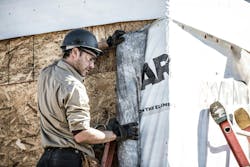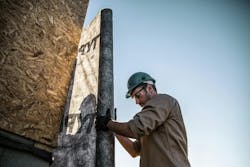The Best Way to Install Housewrap
Proper installation is essential when working with weather-resistant barriers (WRBs) such as building or house wraps. Even when up to code, the performance of these materials can be compromised by improper installation. The good news is, installing building wrap is simple if you stick to these four easy steps:
Step 1: 12-inch overlap and 1-inch overlap on the sill plate. For max protection, aim for 2-4 inches
Building wrap should be installed from the foundation upward, making sure to overlap joints with the higher course overlapping the lower. First, start at the bottom of one end of the wall with the printed side facing out. When starting at a corner, overlap by a minimum of 12 inches. Place the building wrap roll horizontally and roll out the first course evenly, covering rough window and door openings. A minimum of a 1 inch (25.4 mm) overlap on the sill plate is required. However, for maximum protection, a 2-inch to 4-inch (51-102 mm) overlap on the sill plate is recommended. Be sure to pull the building wrap snug and avoid wrinkles and creases.
Step 2: Use plastic-capped nails to attach the building wrap
Additionally, when installing a building wrap over metal frames, you’ll want to use screws and washers. Simply put, the use of caps seals holes made by the penetration of the fasteners. Studies show that homes where cap nails and cap staples were used to attach housewrap resisted air infiltration and water holdout better than those where caps weren’t used. If water is allowed to enter through the staple holes, it becomes trapped, creating the perfect conditions for rot and mold. The more holes, the better the chance for complications and negative long-term effects on the building envelope.
Step 3: Overlap bottom layer by 6 inches, ensure proper shingling, and cover all seams using tape
The upper layer of the building wrap should overlap the bottom layer by a minimum of 6 inches (152 mm) vertically and horizontally. It is also important to take some time to ensure proper shingling throughout the installation to properly shed water. Once the structure is completely covered, tape all seams and penetrations. Sealing all laps and penetrations with the proper tape can improve the building wrap’s performance by 20 percent.
Step 4: Inspect for rips and tears
Once installation is complete, thoroughly inspect the building wrap for any rips or tears before installing the cladding. Even the slightest tear can leave the wall at the mercy of Mother Nature.
Making sure to follow the proper steps when installing your WRB can help protect your building from accumulating moisture damage. A weather barrier system that has been properly installed can help improve the durability of a building, indoor air quality and decrease potential maintenance costs by reducing the risk of moisture intrusion.
About the Author

Bijan Mansouri, TYPAR Construction Projects
Bijan Mansouri is the technical manager at TYPAR Construction Products. He has been with Berry Plastics for more than 25 years working in different technical capacities. He is responsible for building code requirements, design and development of new construction products, training builders and architects on application of new and existing products and creating and education on the proper practice and installation of building envelope. He can be reached at [email protected].


